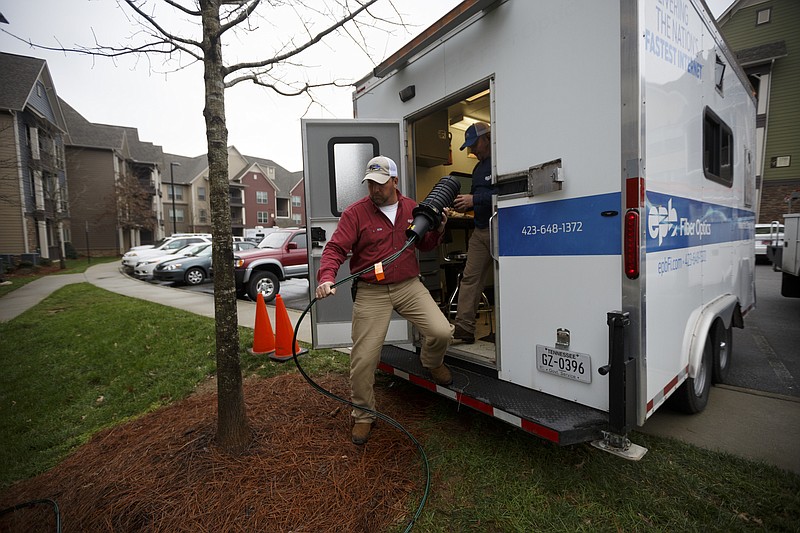The high-speed broadband network built by Chattanooga's electric utility has generated nearly $2.7 billion in economic benefits since it was built more than a decade ago, according to a new economic analysis released Friday.
EPB's fiber optics system, which EPB launched in 2009 with the assistance of a $111.7 million federal stimulus grant during the Great Recession, has helped generate an estimated 9,516 jobs and has lured an extra $244 million in business ventures using the fiber-optic network, according to a study by University of Tennessee at Chattanooga Economist Bento Lobo. The study also estimates that Chattanooga has helped attract $110 million in research projects and saved businesses $260 million in improved power reliability from 2010 through 2020.
EPB originally built its fiber-optic network to create a smart grid to improve its electric service and over the past 10 years the smart grid has helped reduce power outages from 40% to 55% a year. But the fiber- optic lines laid to improve electricity delivery also allowed EPB to offer high-speed internet, including the fastest citywide internet service in America.
"Chattanooga's smart city infrastructure was designed as a platform to give our customers the power to do more," said David Wade, EPB president & CEO. "From education and innovation to job creation, it's amazing to see how our customers are realizing possibilities we could only imagine 10 years ago."
Wade told EPB directors Friday that he is confident even more economic gains will be made as more uses are developed for EPB's fiber-optic system.
Despite criticism from privately owned telephone and telecommunication companies, EPB borrowed more than $220 million in 2009 to build out the fiber network across its 600-square-mile service territory. Lobo said the benefits have far exceeded EPB's initial $396.1 million investment in the fiber optic network and over time EPB has repaid its initial investment and its telecommunications network has helped pay to keep EPB electric rates lower.
"Ten years ago, EPB endeavored to do what many in the utility industry thought was impossible," said Marcus Shaw, the outgoing director of Chattanooga's CompanyLab and EPB director.
Shaw said EPB's bold vision helped create Chattanooga as a "Gig city" with the fastest citywide internet in the Western Hemisphere and a global reputation for innovation that has helped attract entrepreneurs and startup companies to town.
But private telecom companies and cooperatives that often have to compete with municipal broadband services complain that EPB and other government-owned utilities have an unfair advantage, especially in the case of EPB with its initial stimulus grant.
Levoy Knowles, executive director of the Tennessee Broadband Association, said EPB has helped demonstrate the potential and success for broadband coverage in the state. But he said not all municipalities have been as successful.
"Even though EPB has had some successes, we still feel like the private enterprise should take the lead in developing broadband," he said. "Government should not be involved in trying to compete against private enterprise."
The city-owned EPB was able to expedite its broadband plans in November 2009 when EPB secured a Department of Energy grant for $1111.7 million to help fund its smart grid.
"EPB's success is based on government dollars being used to drive out private enterprise," said Amy Martin, executive director of Tennessee's Cable and Broadband Association.
When EPB directors authorized the city-owned utility to build a citywide fiber network and smart grid, EPB projected it would need 30,000 subscribers to its internet services to break even. Today, EPB has more than 118,000 customers who receive either internet, video or telephone services from EPB.
But Martin said the bulk of EPB's customers have come from private rivals like Comcast, Charter and AT&T.
But EPB was able to expedite high-speed service to the entire Chattanooga footprint well before any private telephone or cable TV companies were offering such Gig service.
EPB's gigabyte-per-second service offered citywide in 2010 was upgraded to 10 Gig service five years later and the broadband network was sufficient to easily handle a 75% increase in internet broadband usage since the Pandemic struck in March and thousands of workers shifted to working remotely at home, Wade said.
EPB Vice Chairman Vicky Gregg, a former president of BlueCross BlueShield of Tennessee, said EPB's high-speed internet has helped Chattanooga's "Gig City" maintain more remote business, education and telehealth services than most communities.
"It's been critical through COVID and amazing to see how businesses, schools and others have been able to manage due to the connectivity we've been able to provide at EPB," she said.
Former Chattanooga Mayor Jon Kinsey, another EPB director, credited EPB's broadband services for helping Chattanooga to realize above-average population and economic growth in the past decade.
"It's a phenomenal story and no one else has done it yet, which continues to amaze me," Kinsey said.
The economic study by Lobo released Friday, which EPB paid the university $25,000 to conduct as a measurement of its investment, is the second such study by the UTC economics professor to assess the impact of EPB's pioneering venture to expand its electricity service into telecommunications. Lobo estimated in an earlier 2015 study that EPB's fiber optic system had generated $865 million of benefits in its first six years.
"The true economic value of the fiber optic infrastructure for EPB's customers is much greater than the cost of installing and maintaining the infrastructure," Lobo said. "Our latest research findings show that Chattanooga's fiber-optic network provides additional value because it provides high speeds, with symmetrical uploads and downloads, and a high degree of network responsiveness which are necessary for the smart grid and other cutting-edge business, educational and research applications."
Having Chattanooga's fiber-optic network in place also allowed EPB to join with Hamilton County Schools and other local and state partners last year to launch HCS EdConnect, a fiber-optic broadband internet service provided at no charge to students in Hamilton County who qualify for free or reduced lunches. So far, 7,100 households with more than 12,000 students are connected to HCS EdConnect, Wade said.
Contact Dave Flessner at dflessner@timesfreepress.com or at 423-757-6340.

